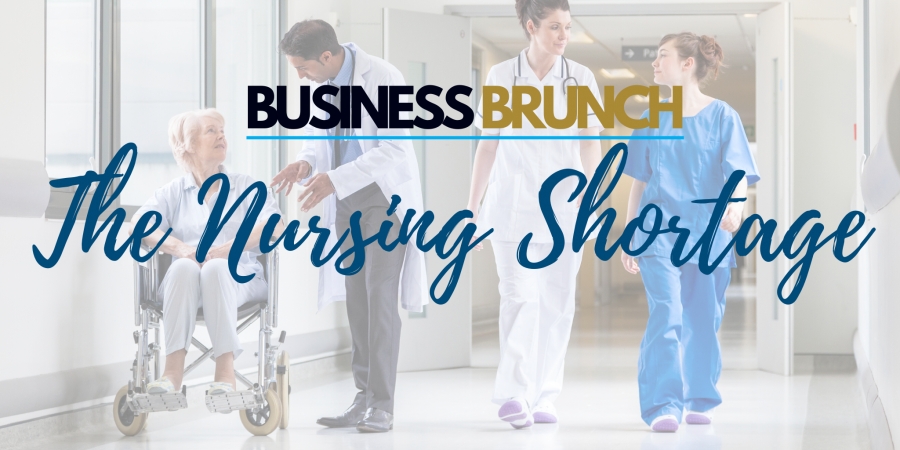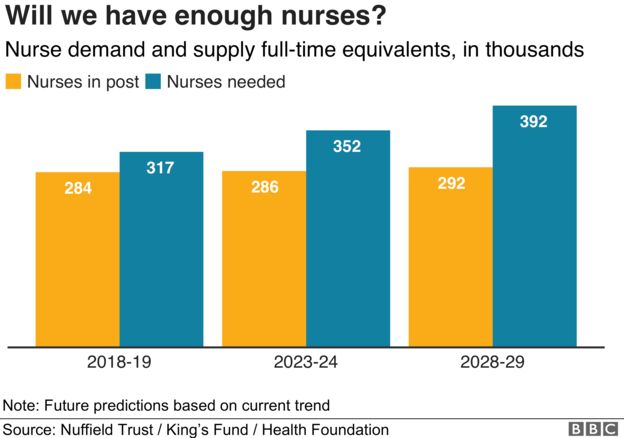
The Nursing Shortage
6th December 2019

You’ve probably heard a lot about the NHS in the news recently, especially with the upcoming election. But we mustn’t let politics overshadow the real problems that our NHS is facing – namely the Nursing shortage.
While the Nursing shortage isn’t the only problem the NHS faces, it is certainly one of the biggest ones according to a report published this week by NHS Providers – a membership organisation for NHS trusts.
We take a look at what the industry experts are saying: how bad is the shortage, what has caused it, and how can we fix it?
How bad is the Shortage?
Estimates currently put us at a shortfall of 30,000 Nurses. This shortage is not due to improve, with this figure jumping up to 100,000 in the next decade should the current trends continue. This graph details the predicted shortfall over the next 10 years:

A shortage of this level will make it much harder to continue running all the vital services the NHS provides. "The workforce is the make-or-break issue for the health service. Unless staffing shortages are substantially reduced, the recent NHS Long Term Plan can only be a wish list." Says report co-author Anita Charlesworth.
What has caused, or contributed, to the shortage?
One of the biggest contributors being blamed is George Osborne's decision to stop paying Student Nurses Tuition Fees and maintenance grants from 2016. Up until this point, all tuition fees for Nurses were paid, and they received a means-tested grant of up to £3,191 a year.
Now, Nursing and Midwifery programmes in England are all paid for by the individual, through the student loan system. The only assistance student Nurses get is a £1000 grant, and some can apply for travel costs to be covered should they incur them during placement.
This has obviously made a Nursing degree less appealing, and we have seen applications for Nursing and Midwifery courses fall since the education funding reforms, with a 31% decrease between 2016 and 2018.
Other reasons include varying uncertainty surrounding Brexit. Figures from the Nursing and Midwifery Council have shown that the number of EU Nurses coming to work in the UK has dropped massively by 87% from 6,382 in 2016/17 to 805 in 2017/18.
In total around 10,000 European Nurses have left the NMC register since the 2016 referendum. Meanwhile, inflow from non-EU countries hasn’t increased enough to compensate for this drop, with total new registrants falling over 10%.
How can we fix it?
Various Think Tanks have been coming up with solutions to this shortfall. A major one is making training as a Nurse in the UK more attractive again.
After the cuts in 2016, the fall of Nursing students was undeniable, and this can only be rectified by reinstating or increases some of the benefits that Student Nurses once got. Suggestions have been made to introduce a £5,200 annual grant to help students pay for their living costs while learning and contribute towards costs incurred during their placements.
Not only this, but they also suggest that students who have already completed a Nursing degree should be exempt from University fees should they wish to retrain, incentivising people to get back into Nursing.
However, they make it clear that the problem cannot be solved by utilising talent in the UK alone. Reports predict that the NHS will need to recruit 5,000 new Nurses from abroad every year to help meet demand. This figure is 3x higher than the number they are currently, meaning a lot more work has to be done.
Once the election drama has died down, it is essential for the party in power to focus on the NHS and make serious considerations to how this huge Nursing shortfall will be mitigated.
Whether this is through retaining or recruiting, it’s clear that without serious intervention, the country will be at serious risk of a fall in reach and quality of our healthcare provisions.
To read the full report, click the link below:
https://nhsproviders.org/the-state-of-the-nhs-provider-sector-october-2019
6th December 2019